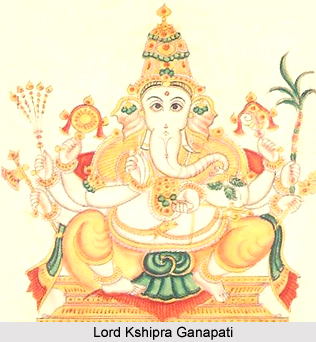 Kshipra Ganapati is one of the forms of Lord Ganesha. This incarnation of Lord Ganesha is believed to be the god who takes fast action, as He immediately fulfills the wishes of His devotees. The elephant-faced deity is depicted with red complexion and handsome features and has four arms. Lord Ganesha carries His own broken tusk on his main right hand and a sprig of Kalpavriksha on the main left hand. He also holds a noose and an elephant goad in His other hands. The trunk of the Hindu god curled towards the right and holds ratnakumbha which is a pot of precious gems and jewels.
Kshipra Ganapati is one of the forms of Lord Ganesha. This incarnation of Lord Ganesha is believed to be the god who takes fast action, as He immediately fulfills the wishes of His devotees. The elephant-faced deity is depicted with red complexion and handsome features and has four arms. Lord Ganesha carries His own broken tusk on his main right hand and a sprig of Kalpavriksha on the main left hand. He also holds a noose and an elephant goad in His other hands. The trunk of the Hindu god curled towards the right and holds ratnakumbha which is a pot of precious gems and jewels.
Some of the popular temples of Kshipra Ganapati are Jyothirmaheshwara Temple in Srirangapattinam, Karnataka; Ashtavinayak Temples in Pune, Maharastra; Kanyakumari Temple in Kanyakumari, Tamil Nadu; Temples in Nanjangud and Chamarajanagar in Mysore; Pillayarpatti Karpaga Vinayagar Temple in Karaikudi, Tamil Nadu; Bhramaramba Mallikarjuna Temple in Srisailam, Andra Pradesh; Manasa Sarovar in Omkar Hills, Bengaluru, Karnataka; Manthakara Mahaganapathi Temple in Kalpathy and others.
Regular mediation on the Kshipra Ganapati form fulfills the wishes of the worshippers and helps them in attaining long-life. The worship of this deity provides knowledge to the devotees. The Kshipra Ganapati Mantra is recited as "Dantakalpalata Pasharatna Kumbhanksho Jvalam Bandhooka Kamaniyabham Dhyaayeth Kshipraganadhipam".
This article is a stub. You may enrich it by adding more information to it. You can send your write-up at content@indianetzone.com




















